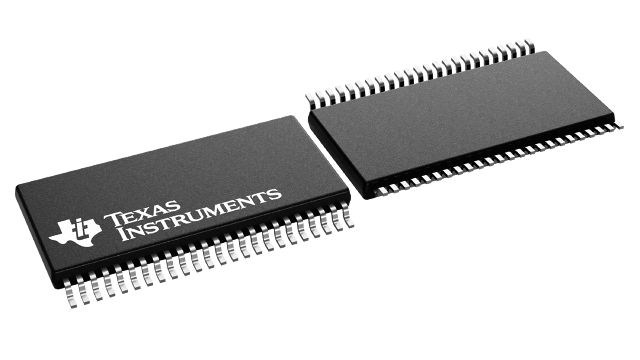Packaging information
| Package | Pins TSSOP (DGG) | 48 |
| Operating temperature range (°C) -55 to 125 |
| Package qty | Carrier 2,000 | LARGE T&R |
Features for the SN74VMEH22501A-EP
- Controlled
Baseline
- One Assembly/Test Site, One Fabrication Site
- Enhanced Diminishing Manufacturing Sources (DMS) Support
- Enhanced Product-Change Notification
- Qualification Pedigree(1)
- Member of the Texas Instruments Widebus Family
- UBT Transceiver Combines D-Type Latches and D-Type Flip-Flops for Operation in Transparent, Latched, or Clocked Modes
- OEC Circuitry Improves Signal Integrity and Reduces Electromagnetic Interference (EMI)
- Compliant With VME64, 2eVME, and 2eSST Protocols Validated at TA = -40°C to 85°C
- Bus Transceiver Split LVTTL Port Provides a Feedback Path for Control and Diagnostics Monitoring
- I/O Interfaces are 5-V Tolerant
- B-Port Outputs (-48 mA/64 mA)
- Y and A-Port Outputs (-12 mA/12 mA)
- Ioff, Power-Up 3-State, and BIAS VCC Support Live Insertion
- Bus Hold on 3A-Port Data Inputs
- 26-Ω Equivalent Series Resistor on 3A Ports and Y Outputs
- Flow-Through Architecture Facilitates Printed Circuit Board Layout
- Distributed VCC and GND Pins Minimize High-Speed Switching Noise
- Latch-Up Performance Exceeds 100 mA Per
JESD 78, Class II - ESD Protection Exceeds JESD
22
- 2000-V Human-Body Model (A114-A)
- 200-V Machine Model (A115-A)
- 1000-V Charged-Device Model (C101)
Description for the SN74VMEH22501A-EP
The SN74VMEH22501A-EP 8-bit universal bus transceiver has two integral 1-bit three-wire bus transceivers and is designed for 3.3-V VCC operation with 5-V tolerant inputs. The UBT transceiver allows transparent, latched, and flip-flop modes of data transfer, and the separate LVTTL input and outputs on the bus transceivers provide a feedback path for control and diagnostics monitoring. This device provides a high-speed interface between cards operating at LVTTL logic levels and VME64, VME64x, or VME320(2) backplane topologies.
The SN74VMEH22501A-EP device is pin-for-pin compatible to the SN74VMEH22501 device (SCES357), but operates at a wider operating temperature range.
High-speed backplane operation is a direct result of the improved OEC circuitry and high drive that has been designed and tested into the VME64x backplane model. The B-port I/Os are optimized for driving large capacitive loads and include pseudo-ETL input thresholds (½ VCC ±50 mV) for increased noise immunity. These specifications support the 2eVME protocols in VME64x (ANSI/VITA 1.1) and 2eSST protocols in VITA 1.5.
With proper design of a 21-slot VME system, a designer can achieve 320-MB transfer rates on linear backplanes and, possibly, 1-GB transfer rates on the VME320 backplane.
All inputs and outputs are 5-V tolerant and are compatible with TTL and 5-V CMOS inputs.
Active bus-hold circuitry holds unused or undriven 3A-port inputs at a valid logic state. Bus-hold circuitry is not provided on 1A or 2A inputs, any B-port input, or any control input. Use of pullup or pulldown resistors with the bus-hold circuitry is not recommended.
This device is fully specified for live-insertion applications using Ioff, power-up 3-state, and BIAS VCC. The Ioff circuitry prevents damaging current to backflow through the device when it is powered off/on. The power-up 3-state circuitry places the outputs in the high-impedance state during power up and power down, which prevents driver conflict. The BIAS VCC circuitry precharges and preconditions the B-port input/output connections, preventing disturbance of active data on the backplane during card insertion or removal, and permits true live-insertion capability.
When VCC is between 0 and 1.5 V, the device is in the high-impedance state during power up or power down. However, to ensure the high-impedance state above 1.5 V, output-enable (OE and OEBY) inputs should be tied to VCC through a pullup resistor and output-enable (OEAB) inputs should be tied to GND through a pulldown resistor; the minimum value of the resistor is determined by the drive capability of the device connected to this input.
